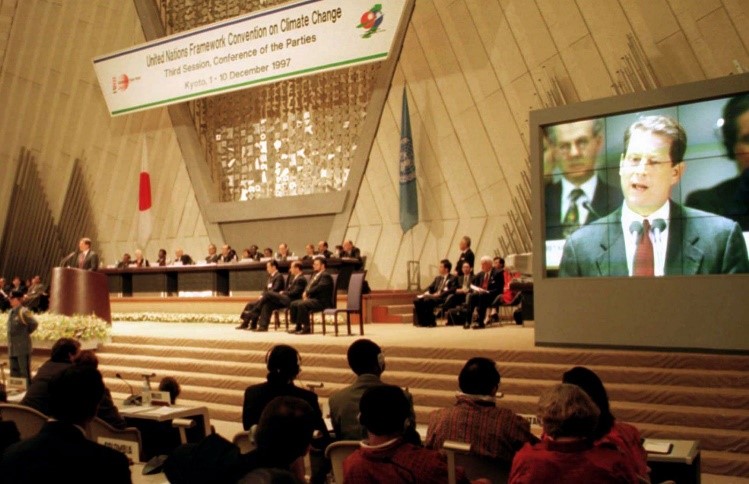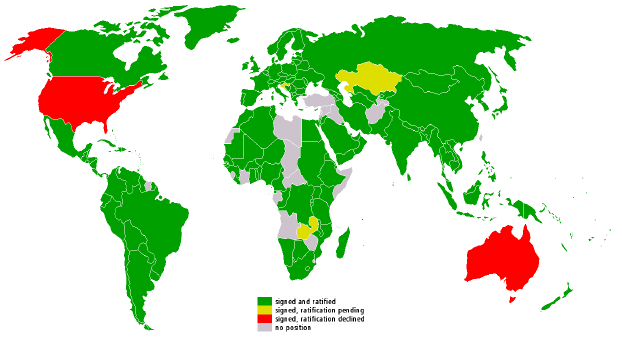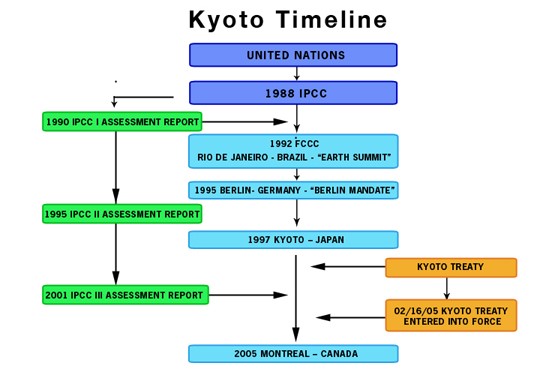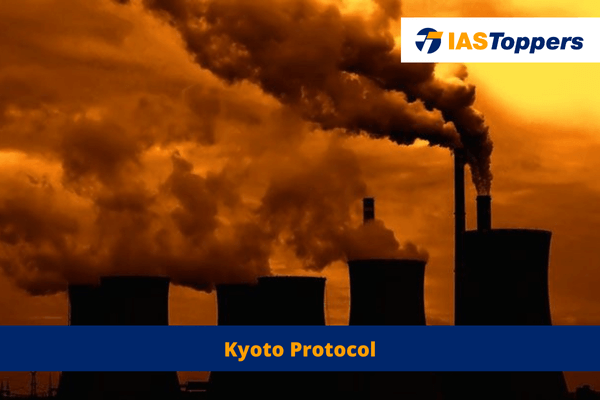The Kyoto Protocol deals with the reduction in release of greenhouse gases (GHGs) into the atmosphere. The protocol was signed in 1997. In this article, you will learn about Kyoto protocol, aim of Kyoto protocol, features of Kyoto protocol, greenhouse gases as per Kyoto protocol providing key insights for GS Paper-III of Environment and ecology section of the UPSC IAS Exam.
Table of Content
- What is Kyoto Protocol?
- Signatories of the Protocol to the UNFCCC
- Objectives of Kyoto Protocol
- The Kyoto Protocol Timeline
- The first commitment period
- The second commitment period
- Conclusion
- Frequently Asked Questions
What is Kyoto Protocol?
- The Kyoto Protocol is an international treaty that aims to reduce the release of carbon dioxide (CO2) and other greenhouse gases (GHGs) into the atmosphere.
- It is legally binding only on the developed countries that is based on the principle of “common but differentiated responsibility and respective capabilities”.
- The Protocol operationalizes the United Nations Framework Convention on Climate Change (UNFCCC).
- Another name: The Protocol to the United Nations Framework Convention on Climate Change.
- The Kyoto Protocol was held in 1997 after the Kyoto Conference was held in Kyoto, Japan.
- The Kyoto Protocolyear of coming into force was 2005.
- There are 192 signatories of this Protocol.

Signatories of the Protocol to the UNFCCC:

Objectives of Kyoto Protocol:
- The Kyoto Protocol aims at reduction of the emission of 6 GHGs.
- The Kyoto Protocol greenhouse gases are carbon dioxide, methane, nitrous oxide, perfluorocarbons, hydrofluorocarbons, and sulphur hexafluoride.
- The signatories of the Protocol must develop national programs to reduce their emissions of GHGs.
- India ratified the protocol in 2002.
- The Kyoto Protocol mechanism: the protocol provides for 3 mechanisms that enable the developed countries to meet the emission limitation and reduction commitments. 3 mechanisms are:
- International Emissions TradingClean Development Mechanism (CDM)
- Joint implementation (JI)
- The Adaptation Fund will help finance the adaptation projects and programmes in developing countries that are Parties to the Protocol.
- The Montreal protocol vs Kyoto protocol: the former was established to phase out substances that deplete ozone whereas the later aimed to reduce the emissions of greenhouse gases, with the exception to ozone depleting substances.
Timeline of Kyoto Protocol:

The first commitment period:
- The first commitment period mandates 41 countries+ European Union to decrease their emission level below 5.2% of 1990 levels over the 5-year period 2008–2012.
- This target was achieved by the nations.
- Most of the obliged nations are industrialized nations and the 12economies in transition (EIT).
- These nations are together known as “Annex I” countries.
- Many of these nations belongs to the Organization for Economic Cooperation and Development (OECD).
- Each nation had a different target to meet by that year.
- These nations and 12 economies in transition (EIT) have to make reductions in GHGs emissions, both from smokestacks and tailpipes.
- The Annex I countries and EIT must together contribute a majority of their financial resources including technology transfer to other countries for climate change initiatives.
- The Global Environment Facility manages the grants and loans provided by these nations.
The second commitment period:
- The second commitment period adopted the Doha Amendment that will be implemented from 2013 to 2020.
- Additional Parties along with the Annex I countries has committed to reduce the GHGs emissions by at least 18 % below 1990 levels.
- Carbon credit Kyoto Protocol: those countries that has ratified the protocol were assigned the maximum carbon emission levels for specific periods and participated in the carbon credit trading.
- If a country emitted more than its assigned limit, then it would be penalized by receiving a lower emissions limit in the following period.
- More GHGs are added in this commitment.
- 147 Parties were signatory to it including India.
Conclusion:
The Kyoto Protocol is related to a collective commitment to mitigate the impacts of climate change while ensuring sustainable economic growth. The protocol serves as a milestone in global efforts to combat climate change, emphasizing the need for cooperation, innovation, and shared responsibility to safeguard the Earth for future generations.
Ref: Source-1
| Other Articles in Environment & Disaster Management | |
| Carbon FootPrint | Smog |
| Black Carbon | Ozone Layer Depletion- Definition, Causes, & Effects |
| Green GDP | Central Pollution Control Board (CPCB) |
FAQs (frequently asked question)
Q. What is the primary agenda of the Kyoto protocol 1997?
The Protocol to the UNFCCC is associated with the reduction in the release of carbon dioxide (CO2) and other greenhouse gases (GHGs) into the atmosphere
When did India signed and ratified Kyoto Protocol?
India had signed and ratified the Kyoto Protocol in 2002.
In which year was Kyoto protocol signed?
The Protocol to the UNFCCC was adopted in in the year 1997.
How many countries signed the Kyoto protocol?
The Protocol to the UNFCCC was signed by the 192 countries.
Which country did not sign the Kyoto protocol?
China, Australia, and the United States has not joined the protocol to the UNFCCC.
What is the difference between Paris agreement and Kyoto protocol?
The Protocol to the UNFCCC was imposed only on developed countries to reduce emissions whereas the Paris Agreement called on all countries to set emissions targets and work towards reducing it.


